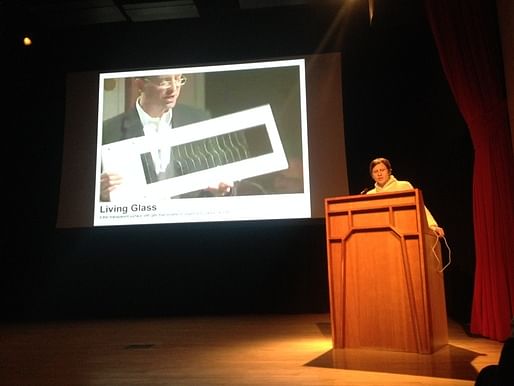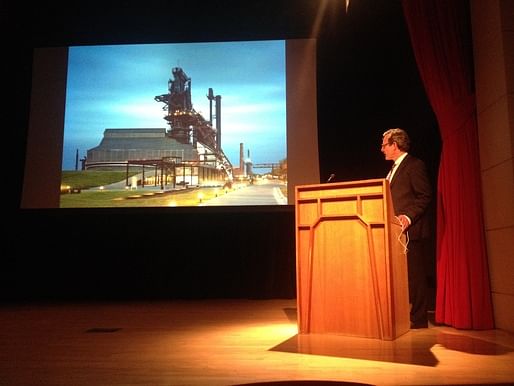
Emerging Voices is an annual award given by the Architectural League. It is an invited portfolio competition, identifying eight firms in North America that are influencing the current condition of architecture, landscape design and built environments. To see a full list of this year’s award recipients, click here. The winners will present their work weekly in a lecture series hosted by the Architectural League of New York during the month of March. For more information about these events, click here.
The Emerging Voices lecture series kicked off last night with presentations by The Living (David Benjamin) and Surfacedesign Inc (Geoff di Girolamo, James Lord, and Roderick Wyllie). Despite the differences in the scope of work between both offices, the pairing offered complementary insights into alternative approaches to designing built environments. David Benjamin’s work is inspired by experimentation and synthetic biology, employing a cross-disciplinary approach to undertake responsive and informative structures. Surfacedesign Inc, on the other end of the spectrum, aspires to create emotional and evocative landscapes, rooting experience in the embedded history of their projects' sites.

The lecture started with a short introduction by Paul Lewis, who aptly described David Benjamin’s work as creating architecture of the future – a point that was proven during the course of Benjamin’s lecture.
Benjamin presented a variety of The Living's inventive projects. Driven by a diversity of collaborations, the chronological presentation of projects provided insight into the flexible process engaged in The Living’s design explorations. Benjamin’s projects are often composed of layers of information, using sensors, new technologies, as well as the public engagement to gather data. Projects like the Breathing Wall anticipate possibilities of using a façade as a responsive building system - it deforms in response to changing CO2 levels and can be used to collect data on an urban scale.

Benjamin adds levels of data communication by integrating collective activity in his Living Light installation in Seoul, Korea, as with his Amphibious Architecture in NYC. Both installations use lights and sensors to register environmental factors (air quality in Seoul, water quality and presence of fish in NYC). The installations create an interface for people to engage with their environment through texts, using a personal level of communication to inform the public while gauging personal interest. Benjamin continues to harness a diversity of technologies for social and material experiments, promoting design with uncertainty. In his collaboration with Autodesk, he inverts the design process by letting go of the typical obsession of control to use computational methods to generate chair designs – arguing that the computer is extending human creativity. He ends his lecture with a brief overview of Hy-Fi – The Living’s winning proposal for PS1’s Young Architects competition. The project proposes a new paradigm for design and manufacturing, by creating a structure made from zero-waste bio-bricks.


Surfacedesign Inc. took the stage next, representing the west coast as a San Francisco based firm – James Lord joking that the firm’s work is primarily in the ring of fire, before doing a whirlwind tour of a few of their projects from all around the world. Principal Geoff di Girolamo started with the Museum of Steel in Monterey, Mexico. The project was a perfect example of how the firm approaches landscape design as the “front door to architecture.” Drawing from a limited budget and the site's history as a steel mill, they integrated found objects from the site to create a narrative, frame views and emphasize features of the architecture.


Surfacedesign also incorporated an extensive and intensive green roof, the largest in Latin America. James Lord then swept in to present the Auckland Airport Gateway and IBM Honolulu. Both projects exemplify how Surfacedesign Inc draws from the local environment, culture and mythology to embed their designs with the language of the place. He describes how the firm tries to understand the stories of a place and incorporates them into a living environment. Roderick Wyllie concluded the Surfacedesign Inc presentation with the Lands End Visitor Center in their firm's backyard, San Francisco. This project explored what a national park could be in an urban context – creating a contemporary visitors' center while working within the constraints of the national parks department.


Following the presentations was a dinner at Le Pain Quotidian, where the presenters were able to chat in depth about their work with an array of New York architects. Seated at a long table (one of the architects pointed out it was a single table constructed from railroad ties – information he inquired about after he’d searched for the seams). Conversation was lively, and the attendees played a little game of musical chairs throughout the dinner to catch up with each other. The present architects talked shop, gossiped and swapped stories – reaffirming that the realities of practicing architecture extend far beyond the glamorous design process, truly consisting of budgeting catastrophes, paperwork bureaucracy and management details.

Amidst this – David Benjamin, James Lord, Geoff di Girolamo, and Roderick Wyllie shared their thoughts on the prize, and exposed more in depth details on their projects. Wyllie expressed how while winning Emerging Voices has generated a lot of excitement around the firm, it also has provided an opportunity to step back and evaluate their work. As a San Francisco based firm, the award also inspired some inquiry about west coast versus east coast architecture, prompting some fellow presenters to share their own opinions. Wyllie noted that Emerging Voices offers a ‘curated snapshot of a particular time in architecture.’ On the international scope of their work, Wyllie expressed excitement to get out of San Francisco and have an opportunity to "stretch his legs".

David Benjamin was repeatedly asked about creating a foundation for their PS1 installation, an annual hurdle for winners of the Young Architects award (admittedly, I was one of the people to ask). This initiated a conversation about the installation itself – as Benjamin is currently iteratively testing the bricks being used in the ‘tower.’ “The material properties can be dialed in,” he explained about the manufacturing of the bricks. The installation is to prove that these bricks are viable building materials that can be strong, waterproof, insulating, and used for tall structures.
Reflecting on the night, both Surfacedesign Inc and The Living offered an interesting lens through which to view built environments, quite successfully kicking off the 2014 Emerging Voices lecture series.
No Comments
Block this user
Are you sure you want to block this user and hide all related comments throughout the site?
Archinect
This is your first comment on Archinect. Your comment will be visible once approved.